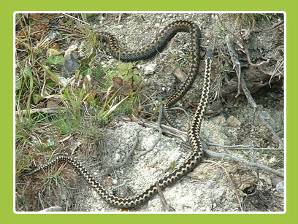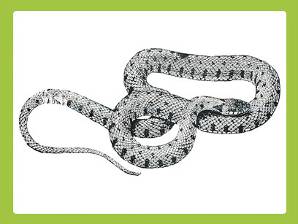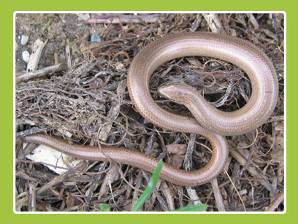SNAKES AND GARDENS
Reptiles - snakes and lizards - are fascinating creatures, but often misunderstood. They are becoming endangered as their habitat disappears following human activity, such as farming, forestry or building. They are protected by law and it is an offence to intentionally kill, injure advertise to sell, or sell any native British reptile.
There are two native species of snake on the Isle of Wight:
| Adders which have broad zigzag markings. Adder: length up to 66cm |  |
 | Grass snakes, distinguishable by their black and yellow collar, and Grass Snake: length up to 120cm Grass snakes are most frequently encountered in gardens. They are harmless and breed in compost heaps. Although adders are poisonous, they are generally timid and not aggressive unless they feel threatened. |
 | Slow-worms, although similar in appearance to snakes are actually legless lizards. They have a bronzy colouration and are frequently seen in gardens or on rough ground. Slow worm: length 30-50cm |
Snakes in your garden may be looking for food, a place to bask in the sun, or somewhere to breed. Although they are generally not a great problem to gardeners, not everyone appreciates them! It is possible to deter snakes for entering your garden, and there are ways of making it less attractive to them by taking away food sources, basking sites or places to hide.
A snake deterrent fence can be made out of overlapping sections of corrugated iron, or corrugated plastic edging material sold by garden centres. This should be about 50cm wide and have 20cm pushed into the ground, leaving a 30cm high fence which people can step over. It should be as smooth as possible to prevent snakes gaining a purchase.
Compost heaps are attractive to snakes because they feed on the beetles, worms and other invertebrates associated with them, and because of the warmth generated as the vegetation rots.
A compost heap can be made less attractive to snakes by raising it above the ground on an old wooden pallet and material too smooth for the snakes to climb, such as sections of plastic drainpipe. An alternative is to use a compost tumble-bin, which is a large plastic drum raised from the ground on a metal frame and designed for rotation to aerate the compost.
Compost heaps are attractive to snakes because they feed on the beetles, worms and other invertebrates associated with them, and because of the warmth generated as the vegetation rots.
A compost heap can be made less attractive to snakes by raising it above the ground on an old wooden pallet and material too smooth for the snakes to climb, such as sections of plastic drainpipe. An alternative is to use a compost tumble-bin, which is a large plastic drum raised from the ground on a metal frame and designed for rotation to aerate the compost.
Wood piles also provide cover and shelter for snakes and they should be tidied away or raised off the ground in the same way as compost heaps.
Garden ponds provide food in the form of goldfish and frogs, and can be made less attractive to snakes by netting with a mesh too small to permit the snake access, or by building a snake-deterrent fence around the pond.
Rockeries are very attractive to snakes, particularly if they are south-facing. It is quite difficult to modify them, so the only option is to look carefully before approaching and make sure your hands and feet are protected against bites.
Mown grass with no cover tends not to be crossed by snakes, so the shorter you can keep the lawn, the less attractive it will be to snakes. Longer grass, on the other hand, provides both better shelter and foraging territory.
There is no guarantee that any of these measures will keep the adders out completely. They are generally timid and will move away if disturbed. They are most likely to bite if they perceive a direct threat e.g. being accidentally touched or stood on, or sniffed by a dog. It is possible to scare a snake by gently touching it with a long stick, when they will generally leave immediately. As adders are venomous, it would be unsafe to attempt to pick one up.
Should someone be bitten, keep the patient calm and seek medical advice. First aid advice is available from organisations such as St John Ambulance or Red Cross, and it may be worth consulting them in case you have visitors who are unaware that snakes may be in the garden. If you have an existing medical condition which may be made worse by a snake bite, you should consult your doctor for advice.
Further information is available in the Natural England publication ‘Reptiles in your garden: your questions answered’.
Garden ponds provide food in the form of goldfish and frogs, and can be made less attractive to snakes by netting with a mesh too small to permit the snake access, or by building a snake-deterrent fence around the pond.
Rockeries are very attractive to snakes, particularly if they are south-facing. It is quite difficult to modify them, so the only option is to look carefully before approaching and make sure your hands and feet are protected against bites.
Mown grass with no cover tends not to be crossed by snakes, so the shorter you can keep the lawn, the less attractive it will be to snakes. Longer grass, on the other hand, provides both better shelter and foraging territory.
There is no guarantee that any of these measures will keep the adders out completely. They are generally timid and will move away if disturbed. They are most likely to bite if they perceive a direct threat e.g. being accidentally touched or stood on, or sniffed by a dog. It is possible to scare a snake by gently touching it with a long stick, when they will generally leave immediately. As adders are venomous, it would be unsafe to attempt to pick one up.
Should someone be bitten, keep the patient calm and seek medical advice. First aid advice is available from organisations such as St John Ambulance or Red Cross, and it may be worth consulting them in case you have visitors who are unaware that snakes may be in the garden. If you have an existing medical condition which may be made worse by a snake bite, you should consult your doctor for advice.
Further information is available in the Natural England publication ‘Reptiles in your garden: your questions answered’.
Page last updated on: 02/11/2010





